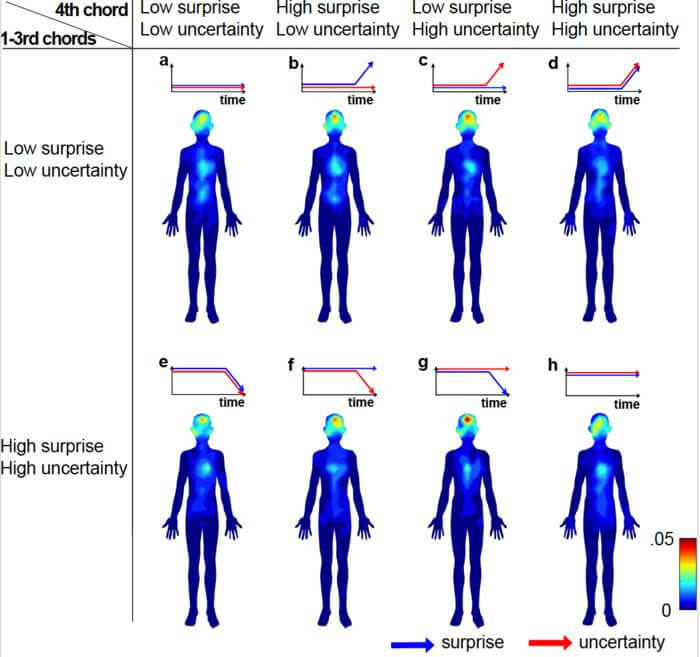TOKYO — Everyone has their personal preference when it comes to music, but we can all agree a world without tunes would be far less fun. Besides busting a move, researchers from the University of Tokyo and Hiroshima University are detailing how music evokes different bodily and emotional responses depending on our expectations. Their findings reveal that music which surprises us can evoke feelings in the heart, whereas music that aligns with our expectations can bring about feelings of calmness and satisfaction.
To reach these findings, study authors played eight short tunes consisting of just four chords each to a group of over 500 study participants. Each one of those tunes featured a varied mix of surprising and unsurprising and certain or uncertain chord progressions. After listening, everyone reported how the songs made them feel and where they felt something. The ensuing answers showed that fluctuations in predictions regarding chord sequences materialized in specific parts of the body, more specifically, the heart and abdomen.
Importantly, sensations in the heart showed a strong link to aesthetic appreciation and feelings of pleasure. All in all, this work may hold crucial implications regarding the use of music to improve well-being.
“Our research shows that some chord sequences create similar bodily sensations in certain organs, particularly in the brain, heart and abdomen,” says Associate Professor Tatsuya Daikoku from the Graduate School of Information Science and Technology at the University of Tokyo, in a media release. “This indicates that our interoceptive sense, that is the sensations felt from within the body, may to some degree underlie musical aesthetic appreciation and positive emotion.”

Using 890 songs on the U.S. Billboard music charts, researchers created eight sequences of four chords for study participants to hear. Importantly, each song featured a mix of low and high surprise and low and high uncertainty by which the chords progressed. In all, 528 people listened to the four-chord tunes and subsequently reported where in their body they felt the music and how strongly. Participants also had to rank their top five emotional responses to each sound using a list of options in addition to how much they believed the music either appealed to them or repulsed them.
By combining these responses, researchers created a distinct body map for each chord sequence. Among the eight sequences, the strongest abdominal sensations occurred when all four chords progressed with low surprise and low uncertainty – researchers called this the sLuL-sLuL sequence. This very predictable tune usually brought out feelings of calmness, relief, satisfaction, nostalgia, and empathy.
The strongest cardiac sensations, meanwhile, occurred when the first three chords played with low surprise and low uncertainty, but the final fourth chord elicited high surprise and low uncertainty. Called the sLuL-sHuL sequence, this tune and the stronger sensations it produces in the heart appear closely linked to stronger feelings of pleasure.
Study authors explain both the sLuL-sLuL and sLuL-sHuL progressions evoked aesthetic appreciation and reduced negative feelings of anxiety and awkwardness. Conversely, the sequences generating strong sensations in the head showed a significant association with feelings of confusion and anxiety. Since this study focused primarily on subjective sensations and emotions, moving forward study authors want to ascertain how more quantifiable physical responses, such as changes in heartbeat, may overlay the map of reported sensations.
“Music is not just something we listen to with our ears; it’s an experience felt throughout the entire body. I think this full-body sensation is what truly defines music,” Prof. Daikoku concludes. “This research offers insights into how musical experiences are intricately connected to our bodies. It holds promise for contributing to the use of music in stress relief and enhancing mental health.”
The study is published in the journal iScience.
